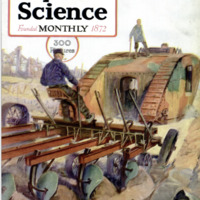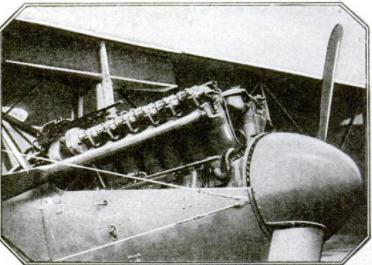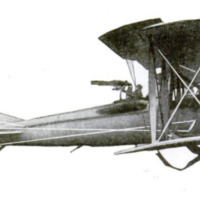U. S. warplane used to carry mail in peace time
Item
-
Title (Dublin Core)
-
U. S. warplane used to carry mail in peace time
-
Article Title and/or Image Caption (Dublin Core)
-
Title: The Flying Mail's Big Debt to War
-
Subtitle: America again takes front rank in the air with machines of mighty power
-
extracted text (Extract Text)
-
THE accompanying pictures illus-
| trate the representative result
of what four years of war-
stimulated progress have done for the
flying-machine. It is the up-to-date
representative of that medium-sized
biplane with which the Wright Bro-
thers inaugurated flight because it was
inherently the most efficient type. It
still has room for only two flyers; but
that it has lift enough for twice that
number becomes apparent from its
formidable battery of eight machine-
guns.
The essential mechanical advance
is seen at a glance: the torpedo shape
of the whole, and a display of power
that suggests a locomotive. Fortu-
nately. this machine. which is the equal
I "not “the superior o! ihe |
best in the world, is again
as purely an American
product as was the original
Wright flyer. But the |
‘Wrights flew with 30 horse- |
power, while the biplane of
to-day flies with 435!
The Liberty Motor ~~
Yet this is one reason
why Americans are again
in the front rank of flying. |
1t is in the big things that
we excel. The watchlike
finish required in smaller |
perfected motors of the high- |
est grade was long unat- |
tainable under American |
conditions; and finally, at |
great expense; the French |
Hispano-Suiza motor was
transplanted to this country. |
On the other hand, the big Liberty
‘motor aimed at once at many hundreds
of horsepower, and American ingenu-
ity in designing won over labor condi-
tions. The war's necessities for extreme
speed and extreme lift, as required in
the poorly supporting thin air of ex-
treme altitudes and for very rapid
climbing in emergencies, were responsi-
ble for the astounding increase of power
from 30 to 435.
At first this would seem the height of
extravagance in a machine devoted to
any but military ends. But humanity
is to be congratulated in that war
development was, after all, identical
with peace development. Only great
reserve power (as required for war
climbing) makes flying safe under ad-
verse conditions; and only by extreme
speed can flying compete ‘with other
modes of locomotion. Only in the
air is such speed useful, because only
there does it find a clear road.
Now that the war is over, the air-
plane shown above will transport mail
in place of its heavy battery, and if it
had been designed for that purpose it
could not be better fitted to its present
purpose. In mail-carrying speed is
everything. The only concession to
peace requirements should be the ad-
dition of a carbureting device to permit
low-priced fuel of high heat value, such
as crude ofl, to be consumed. It seems
by no means impossible, especially as
the engine might be started and
warmed up with gasoline.
The extreme torpedo shape of the
airplane is the natural outcome of ex-
treme power and speed.
Such extreme speed could formerly
have been attained only if (by re-
ducing wing surface and camber) the
landing speed were likewise raised to a
dangerous degree. But now it is
different. Together with the greatest
power, machines are also given plenty
of wing surface and an ample camber
of the wings, making the wings very
lifting. As this would make them
climb rapidly at top speed (while insur-
ing sufficient support at a low, safe
landing speed), they are simply driven
“downhill” —thus transforming climb-
ing into horizontal motion—to fly
horizontally at top speed. Driving
“downhill” would seem like pulling
down with the propeller. But the mod-
ern tractor propeller in front sends
its slip-stream against the
planes, and that slipstream
acquires a lifting component
at the same rate that the
propeller pulls downward.
A Seeming Contradiction
In the machine shown the
radiator in the slip-stream
directly under the upper
wing seems a surprising con-
tradiction to the “torpedo
shape” of the whole. It
especially seems to ruin the
lift or that portion of the
lower surface of the upper
plane which is directly be-
hind it, and of the corre-
sponding upper surface of
the lower plane. But the
lift of the lower surface is
at least less than one-fourth
of that of the upper one.
And under theradiator there is no upper
surface of a bottom plane but a fusel-
age. Also a radiator could not be
placed in a better position for maxi-
mum cooling than into the strongest
part of the slip-stream. Hence it is
ridiculously small for 435 horsepower,
and saves further resistance by being
unusually deep. The tremendous fan
effect makes its long channels cooling
enough.
-
Contributor (Dublin Core)
-
Carl Dienstbach (Article writer)
-
Language (Dublin Core)
-
eng
-
Date Issued (Dublin Core)
-
1919-02
-
pages (Bibliographic Ontology)
-
78
-
Rights (Dublin Core)
-
Public domain (Google digitized)
-
Archived by (Dublin Core)
-
Davide Donà
-
Marco Bortolami (editor)
 Popular Science Monthly, v. 94, n. 2, 1919
Popular Science Monthly, v. 94, n. 2, 1919




